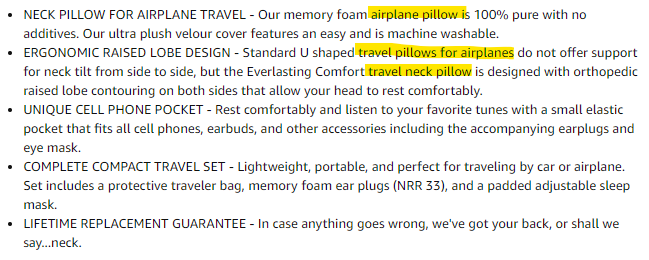Amazon Keyword Research Tips – Product Page SEO Strategies
Have you ever wondered how buyers find your products on Amazon? And wanting to learn more about creating Amazon product pages that really sell?
One of the most important aspects of creating new listings on Amazon is to make sure that the buyer can actually find your product. I know that sounds obvious, but do you know how to make that happen?
Let’s take a few minutes to go over some Amazon keyword research tips to help you optimize your Amazon product page.
Informative Product Title – with high volume and relevant keywords
When buyers are searching for an item on Amazon, they are more likely to start by typing the keyword of that product in the Amazon search bar, rather than filter through the categories section.
Product title is surely the most critical place to include keywords. One important thing to note is that Amazon has implemented a 200-character title maximum for all categories, your items will not be found unless you’ve shortened the tile to less than 200 characters. Also since product title is the first source of information that customers see, it is important to incorporate the following formula in product titles:
Product Brand/Description + Product Line/Collection + Material/Ingredient + Color/Size + Quantity
Products with clear and informative titles are more likely to get higher click-through-rate and ranking. Moreover, this will increase your product visibility on Amazon and your product will possibly be listed on the first search results page, which provides a direct link to your product. You can utilize easy tools like Amazon keyword research tool to see what keywords are highly searched for on Amazon and incorporate those into your product’s title. Try to keep the keywords of your product title relevant to the actual product itself.
Compelling Product Description – with multiple product-related keywords
Amazon wants high-quality content that is relevant and compelling, so don’t copy the description provided by the manufacturer or from your competitors’. A good product description is easy to read, tailored for every product, and how it can fit into buyers’ life.

So why not take advantage of your product descriptions to plug in your product keywords and get your products found. Anecdotally, the bullet points seem to be more influential on search rankings than the description and it can effectively draw attention.
- You get 100 characters per bullet point, so make sure the words are appealing. Here are some tips:
- Highlight the top 5 features and how they benefit buyers
- Reiterate important information from listing title and description
- Incorporate SEO keywords
- Include relevant and compelling information
- Do not include price or promotional content
- Do not include ending punctuation
On top of the 5 bullet points, you get 2,000 characters to describe your product. These should be the exact same keywords or phrases that you are using in the Amazon product listing’s title. You can further expand your bullet points in more detail which helps your customers.
Optimize Back-end Search Terms – with long-tail SEO keywords

This is where you can find in your seller central and put your other keywords that didn’t fit in your title and description. These search terms are invisible to buyers and will get indexed by Amazon’s A9 algorithm.
This is a great place to type in your long-tail SEO keywords and includes the following things:
- Some frequently used keywords in your niche, extra product information
- Other synonyms that buyers might look for
- Other languages that people also use in your market, local slang
- Commonly used misspellings of your brand name or products
It allows you to put in extra 5 lines of 1,000 characters each, which is a great opportunity to add more keywords that will hopefully lead to more traffic. One thing to note is you don’t need to duplicate keywords in your listing. Once a term is typed in the title, bullets, or description, you don’t need to repeat that in your back-end search terms. Although back-end search terms are not required by Amazon, the back-end information is essential for your product pages to rank well in the Amazon search result.
Effective Amazon SEO strategies should be accurate and time-saving
Doing keyword research for Amazon listing can indeed be a time-consuming and repetitive process. So you need a comprehensive keyword research tool that will help you quickly identify the high volume keyword, relevant long-tail keyword, the popular keywords of each category, and even your competitor’s keywords.
You can check out BQool’s latest keyword research tool. Its features include Keyword Generator, Reverse ASIN, and BigKeywords that can help achieve effective Amazon SEO strategies. The following video guide will explain how they work.
Amazon is a huge search engine when it comes to searches for products, and keyword searches are important determinants of your selling success on Amazon. Remember to review your keywords frequently and follow these simple tips to optimize your Amazon listing page.
Now we have a limited-time free trial for 30 days. Don’t miss out!











July 21, 2022
Thanks for sharing this content. The content helps the sellers do well in their SEO with these strategies and boost their Amazon marketing.